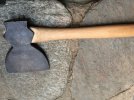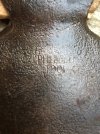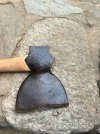- Joined
- Jul 7, 2014
- Messages
- 2,021
My father in law asked me to see what I could find about an axe that his wife bought for him.
He sent me photos, and it appears to be a Philadelphia Tool Company broad axe on a newer handle. I did some searching, and it sounds like this was one of Plumb's brands.
However, the stamps I have seen are different than this one with a script-like font rather than the all caps stamp you see here. It would be neat to get an idea on the date range and authenticity for it.
He has plans of building his own cabin one day, so it will certainly he of use to him as he hews down poplars!



He sent me photos, and it appears to be a Philadelphia Tool Company broad axe on a newer handle. I did some searching, and it sounds like this was one of Plumb's brands.
However, the stamps I have seen are different than this one with a script-like font rather than the all caps stamp you see here. It would be neat to get an idea on the date range and authenticity for it.
He has plans of building his own cabin one day, so it will certainly he of use to him as he hews down poplars!







